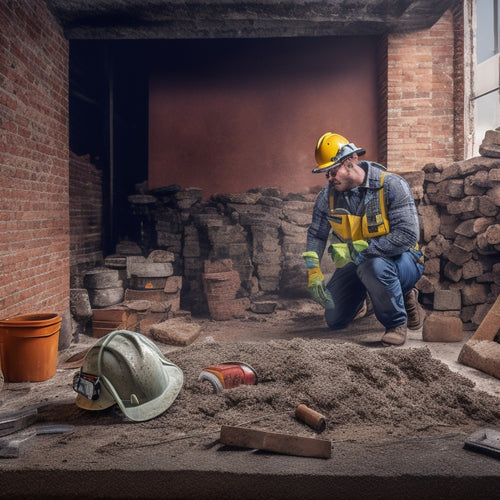
Best Saws for Demolition and Renovation Projects
Share
When tackling demolition and renovation projects, you'll need a saw that can efficiently cut through concrete, asphalt, and tile. For reinforced concrete, opt for a heavy-duty saw with a diamond-coated blade, such as the Husqvarna K 970 or Makita EK7651H. Consider electric saws with high-torque motors and adjustable speed controls for precision cutting. Don't overlook safety precautions, like wearing personal protective equipment and maintaining your saw regularly. As you choose the right saw and technique for your project, keep in mind factors like concrete type, age, and embedded materials to guarantee peak performance and efficiency - and get ready to take your concrete cutting skills to the next level.
Key Takeaways
• For heavy-duty demolition projects, choose saws with diamond-coated blades and high-torque motors for optimal performance and efficiency.
• Consider the type of concrete, age, and embedded materials to select the right saw and cutting technique for the project.
• Electric saws are preferred for precision and controlled cuts, while gas-powered saws offer portability and high power output.
• Regular saw maintenance, correct blade usage, and adherence to safety guidelines are crucial for successful demolition and renovation projects.
• Mastering various cutting techniques, such as plunge cutting, step cutting, and free-hand cutting, is essential for achieving professional results.
Choosing the Right Concrete Saw
When tackling a demolition or renovation project, you need a concrete saw that can efficiently cut through concrete, asphalt, or other hard materials. Selecting the right one depends on the type of project, the size of the area to be cut, and the level of precision required.
You'll want to take into account the types of concrete you'll be working with, as some saws are better suited for cutting through high-strength concrete, while others are designed for softer, more porous materials.
The saw blade is also an essential factor, as different blades are optimized for specific cutting tasks. For example, a diamond-coated blade is ideal for cutting through thick, reinforced concrete, while an abrasive blade is better suited for cutting through asphalt or tile.
Additionally, you'll need to take into account the power source, as electric saws offer more precision and control, while gas-powered saws provide more raw power and portability.
Top Rated Saws for Concrete Demolition
By considering factors like blade type, power source, and cutting capacity, you can narrow down your options to the top-rated saws for concrete demolition, which are designed to tackle even the toughest projects with ease.
For heavy-duty concrete demolition, look for saws with diamond-coated blades that can withstand the rigors of cutting through thick, reinforced concrete. Electric saws with high-torque motors and adjustable speed controls provide the power and precision you need to make clean cuts.
Some of the best concrete saws on the market include the Husqvarna K 970, the Makita EK7651H, and the Bosch CSG15. These saws boast impressive cutting capacities, ranging from 4 to 12 inches, and are designed for heavy-duty use.
When selecting a concrete cutting tool, consider the specific demands of your project and choose a saw that can handle the task at hand. With the right saw, you'll be able to tackle even the most challenging concrete demolition projects with confidence and precision.
Demolition Saw Safety Precautions
You must always wear personal protective equipment (PPE) and follow strict safety protocols when operating a demolition saw to minimize the risk of injury or accident. This includes wearing safety glasses, ear protection, a dust mask, and gloves to protect yourself from flying debris and harmful particles.
Additionally, verify you're wearing durable, long-sleeved clothing and pants to prevent cuts and abrasions.
Regular saw maintenance is also essential to prevent accidents. Before each use, inspect your saw for any signs of wear or damage, and perform routine maintenance tasks such as cleaning and lubricating moving parts.
Make sure you're using the correct blade for the job, and that it's properly secured to the saw.
When operating the saw, maintain a firm grip and keep a stable stance to prevent loss of control. Always cut away from your body, and avoid applying excessive pressure, which can cause the saw to kick back or bind.
Factors to Consider in Concrete Cuts
As you prepare to make precise cuts in concrete, several factors come into play, including the type of concrete, its age, and the location of rebar or other embedded materials. These factors will influence the type of saw and blade you choose, as well as the cutting technique you employ.
For instance, older concrete may be more brittle and prone to cracking, requiring a more gentle touch and a specialized blade. You'll also need to take into account the cutting depth, as this will determine the type of saw you need and the amount of power it requires.
When it comes to blade types, you'll have to decide between diamond blades, which are ideal for cutting through hard, abrasive materials, and abrasive blades, which are better suited for softer materials.
The location of rebar or other embedded materials is also significant, as you'll need to avoid cutting into these areas to prevent damage to the saw or injury to yourself.
Concrete Cutting Techniques and Tips
Concrete Cutting Techniques and Tips
Your concrete cutting project's success hinges on mastering various techniques, including plunge cutting, step cutting, and free-hand cutting, each with its own set of challenges and requirements. To achieve precise cuts, you need to understand the strengths and limitations of each method. Here's a breakdown of the techniques and tips to get you started:
| Concrete Cutting Methods | Blade Selection Tips |
|---|---|
| Plunge Cutting | Use a diamond blade with a high concentration of diamonds for aggressive cutting |
| Step Cutting | Choose a blade with a segmented rim for improved cooling and reduced wear |
| Free-Hand Cutting | Select a blade with a continuous rim for smooth, precise cuts |
When selecting a blade, consider the type of concrete you're working with, the depth of the cut, and the power of your saw. For example, if you're cutting through heavily reinforced concrete, you'll need a blade with a high diamond concentration to withstand the abrasive material. Additionally, always follow safety guidelines, such as wearing protective gear and maintaining a stable work environment, to guarantee a successful and safe concrete cutting project.
Frequently Asked Questions
Can I Use a Demolition Saw for Landscaping and Gardening Projects?
Can you use a demolition saw for landscaping and gardening projects? You can, but it's not the best choice.
Demolition saws are designed for heavy-duty demo work, not precision landscaping techniques. They're too aggressive and might damage plants or surrounding soil.
For landscaping, you'll want a saw with more finesse, like a pruning saw or a reciprocating saw with a pruning blade. These tools will give you the control and precision you need to tackle your outdoor projects with ease.
Are Cordless Saws Suitable for Heavy-Duty Demolition Work?
You're wondering if cordless saws can keep up with the behemoths of demolition work, aren't you?
Think of it like Hercules' mighty labors - can a cordless saw really tame the beast of heavy-duty demolition?
The answer lies in its power. Look for cordless saws that boast heavy-duty performance, with high-torque motors and advanced battery tech.
If it can deliver the grunt, you'll be ripping through demo work like a hot knife through butter.
How Do I Clean and Maintain My Demolition Saw Blades?
You need to properly clean and maintain your demolition saw blades to guarantee peak performance and extend their lifespan.
Start by storing your blades in a dry place, away from direct sunlight, and use a soft cloth to wipe off debris.
Next, master sharpening techniques, such as filing or using a diamond stone, to maintain a sharp cutting edge.
Regularly inspect your blades for damage and replace them when necessary to prevent accidents.
Can I Rent a Demolition Saw Instead of Buying One?
Considering renting a demolition saw instead of buying one? You'll want to weigh the benefits.
Renting can be a cost-effective option, especially for one-time or infrequent use.
Compare the rental cost to the purchase price and calculate the break-even point.
If you'll be using the saw frequently, buying might be the better choice.
However, if it's a one-off project, renting can save you money and storage space.
Are There Any Specific Regulations for Using Demolition Saws in Residential Areas?
When you're planning to use a demolition saw in a residential area, you'll need to check local noise regulations to avoid disturbing the peace.
Additionally, you must familiarize yourself with safety guidelines, such as wearing protective gear and ensuring the saw is in good working condition.
You'll also need to obtain any necessary permits and follow proper disposal procedures for debris.
Failure to comply can result in fines or even project shutdowns.
Conclusion
You've got the right saw for the job, and now it's time to put it to work.
Remember, proper technique and safety precautions are key to a successful demolition or renovation project.
Take, for example, the case of a contractor who used a high-performance concrete saw to remove a damaged foundation from a 100-year-old building.
With precise cuts and minimal dust, the project was completed ahead of schedule and under budget - a demonstration of the power of the right tool in the right hands.
Related Posts
-

7 Must-Have Safety Gears for Brick Wall Renovation
When renovating a brick wall, you'll face a multitude of hazards, making it essential to wear and use the right safet...
-

10 Best Power Tools to Buy for Home Renovation
To tackle your home renovation project efficiently, you'll need the right power tools for the job. A cordless drill f...
-

3 Beginner-Friendly Tools for Plaster Renovation Success
You'll be glad to know that the three essential tools you need for a successful plaster renovation are the same ones ...


